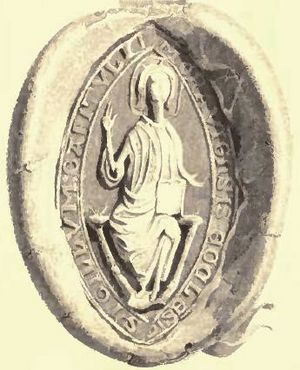Andrew Stewart (bishop of Moray) facts for kids
Quick facts for kids Andrew Stewart |
|
|---|---|
| Bishop of Moray | |
 |
|
| Church | Roman Catholic Church |
| See | Diocese of Moray |
| In Office | 1482–1501 |
| Predecessor | William Tulloch |
| Successor | Andrew Forman |
| Orders | |
| Consecration | 1485 x 1487 |
| Personal details | |
| Born | 1442 x 1445 Scotland |
| Died | 29 September 1501 Moray |
| Previous post | Dean of Moray |
Andrew Stewart (died 1501) was an important Scottish church leader and administrator in the 1400s. He became the Bishop of Moray, a significant role in the church.
Contents
Andrew Stewart's Early Life and Education
Andrew Stewart was born in Scotland between 1442 and 1444. His mother was Joan Beaufort, who was the widow of King James I of Scotland. His father was James Stewart, the Black Knight of Lorne.
Because he was a third son, it was common for him to join the church. This path offered good opportunities for education and a career.
Starting His Church Career
By 1455, Andrew already held several church positions. He was the Sub-Dean of the diocese of Glasgow. For a short time, he was also the Dean of the diocese of Aberdeen.
These early roles helped him pay for his university studies. In 1455, Pope Calixtus III officially gave him these positions.
His University Studies
Andrew began studying at the University of Glasgow in 1456. He later earned his first degree, a bachelor's degree, from the University of St Andrews around 1462 or 1463.
He also studied at the famous University of Paris in 1465. By 1460, he became the Dean of Moray, while still holding his position in Glasgow. Later, in 1477, he was also the Provost of the Collegiate church of Lincluden.
Becoming Bishop of Moray
Andrew Stewart's career reached its highest point after Bishop William Tulloch passed away in 1482. Andrew was chosen to be the new Bishop of Moray.
Papal Approval and Consecration
The Pope officially approved his appointment on August 12, 1482. However, he was not officially made a bishop until sometime between late 1485 and late 1487.
For a short time, he was also the Keeper of the Privy Seal of Scotland. This was an important government job, which he left in early 1483.
Challenges and Reconciliation
Andrew had hoped to become the Archbishop of St Andrews, an even higher church position. He even supported Alexander Stewart, Duke of Albany, who was trying to become King of Scotland. This alliance ended by 1485 when the Duke was defeated.
Despite facing some difficulties with King James III of Scotland and the Pope, Bishop Andrew continued his work. He was likely back in good standing by 1487 when he became a consecrated bishop.
Bishop Andrew's Later Years
As Bishop of Moray, Andrew Stewart led important meetings with the church leaders in Moray in 1487. He also created several rules for the church.
Diplomatic Activities
Bishop Andrew was involved in some important discussions with England. In May 1497, he received permission to travel to England. King Henry VII of England even asked for Bishop Andrew to be sent as a messenger to England in July 1497.
His Death and Burial
On August 13, 1501, Pope Alexander VI made a special note about the bishopric of Moray. This suggested that the Pope expected the position to become vacant soon, perhaps because Bishop Andrew was ill.
Bishop Andrew Stewart passed away on September 29, 1501. He was buried in Elgin Cathedral, a beautiful and historic church.

